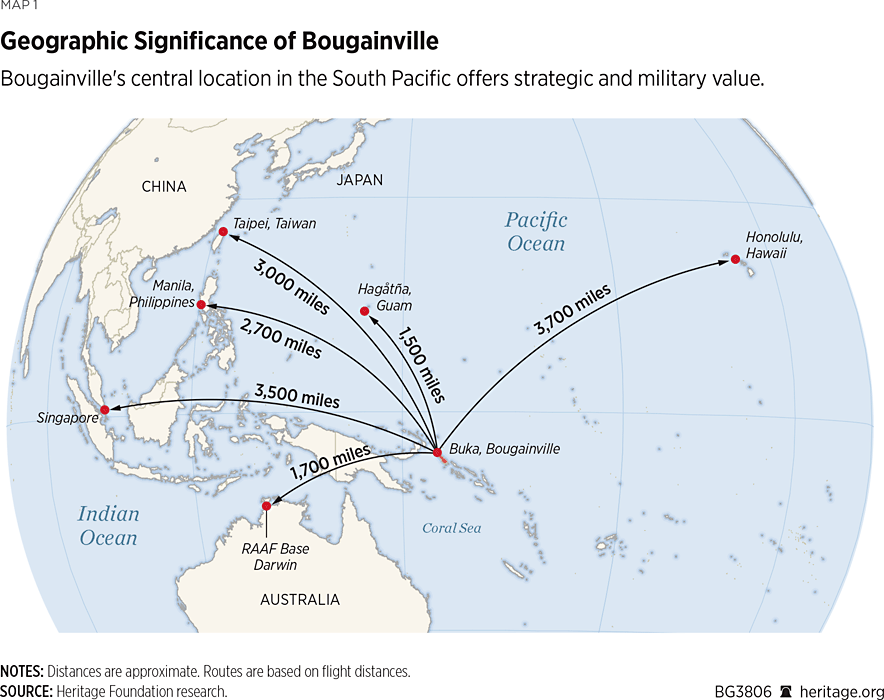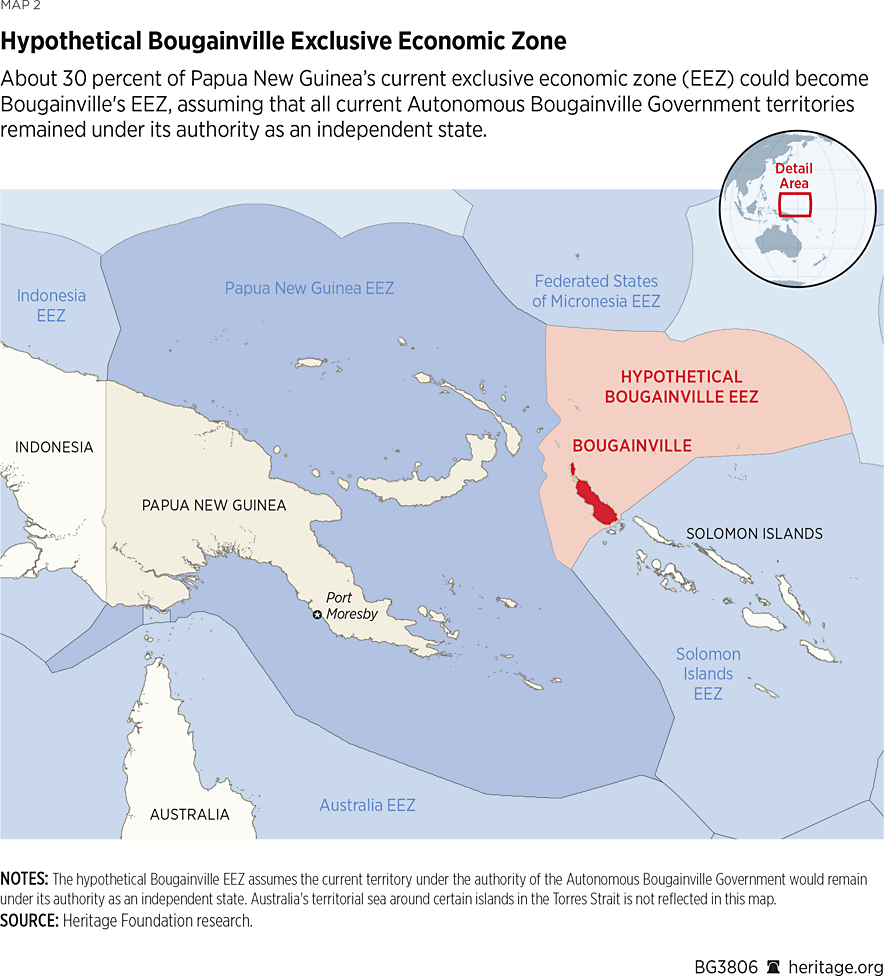The name “Bougainville” (pronounced Bo-gan-ville) is etched into the Iwo Jima Memorial in Arlington, Virginia. Americans with long memories may recall Bougainville’s role in World War II when it was occupied by Imperial Japan and then liberated by a combined force of Americans and Australians in a bloody campaign that cost thousands of lives.REF
Today, there is a distinct possibility that the Autonomous Region of Bougainville, currently part of Papua New Guinea (PNG), will become the world’s newest country by 2027.REF Unsurprisingly, China is already preparing for this possibility.REF As competition between the U.S. and China expands throughout the Pacific Islands, the United States, while maintaining its strong partnership with the PNG government, needs to plan proactive—rather than reactive—engagement strategies for an independent Bougainville, which could alter the regional diplomatic and security landscape.
Background
The Autonomous Region of Bougainville is a discreet portion of PNG. Its total area is approximately 3,600 square miles, the vast majority of which comprises Bougainville Island. Bougainville Island also happens to be the largest island of the Solomon Islands archipelago. An official 2011 census recorded an approximate population of 250,000, with current estimates of around 300,000.REF The majority of Bougainvilleans are Melanesians and Christians.
Bougainville has been seeking independence from PNG for decades. In 1968, when PNG was under Australian control, Bougainville unsuccessfully called for a referendum to either become independent or be incorporated into the Solomon Islands.REF In 1975, just weeks before PNG’s independence, PNG disregarded Bougainville’s own declaration of independence.REF
A key friction point between Bougainville and PNG has been the Panguna copper mine. As one of the world’s largest open-cut mines with an estimated $60 billion worth of copper, the mine once accounted for 45 percent of all of PNG’s exports, though only 1 percent of profits went to local Bougainvilleans.REF In 1989, tensions ultimately led local landowners to sabotage and close the mine, resulting in a decade-long civil war—the deadliest conflict in Oceania since World War II—between PNG and Bougainville.REF Ten percent of Bougainville’s population, about 20,000 people, lost their lives.REF
In 2001, the warring parties signed the Bougainville Peace Agreement. The agreement granted Bougainville autonomy over its internal affairs while maintaining PNG sovereignty and control over foreign affairs.REF Notably, the agreement “made amendments to the National Constitution to guarantee a referendum on Bougainville’s future political status.”REF In 2019, Bougainville conducted a referendum in which nearly 98 percent of Bougainvilleans voted for independence.REF The referendum, however, is nonbinding; the Bougainville Peace Agreement states that the “outcome of the referendum will be subject to ratification” by the National Parliament.REF
Bougainville’s leaders have repeatedly stated their intention for Bougainville to become the world’s newest country before 2027.REF Negotiations between Bougainville and PNG, however, have been moving at a glacial pace for years.REF Complicating matters, it is currently unlikely that the National Parliament will act on the referendum’s outcome in Bougainville’s favor. Over time, this could lead to a crisis, including even an armed crisis, between the national government in Port Moresby and the regional government on Bougainville.
Bougainville’s bid for independence has gone unnoticed in Washington. Few U.S. publications and think tanks, with the notable exception of the United States Institute of Peace, have covered the matter.REF Australian think tanks and media, such as the Australian Strategic Policy Institute, however, have been more closely following Bougainville’s interactions with Australia and the PNG national government.REF
The Security Environment
The Pacific Island region has become increasingly important in the United States’ security strategy. The U.S. government is increasingly concerned about China’s growing presence in the region, especially since it signed a security agreement with Solomon Islands in 2022, which granted Chinese military and police access to the Solomon Islands “according to its own needs.”REF For the time being, both the Chinese and Solomon Islands governments have said that neither plans nor intentions exist to construct a Chinese naval base there. But the agreement allows China to “make ship visits to, carry out logistical replacement in, and have stopover and transition in the Solomon Islands,” which raises concerns that a rotational presence could grow into something more permanent. Furthermore, the agreement grants Beijing the right to send Chinese military forces to the Solomon Islands to “protect the safety of Chinese personnel and major projects.”REF

Bougainville has historically possessed strategic and military value. During World War II, Imperial Japan constructed numerous airfields throughout Bougainville, as the islands were considered vital for protecting Tokyo’s major garrison and naval base in Rabaul, PNG.REF The Japanese also used Bougainville offensively as a staging ground for their assault on Guadalcanal, one of the most significant campaigns in the Pacific theater. Allied forces were eventually able to secure the island after fierce fighting. Bougainville has proven its ability to play a strategic role in military operations as a logistics hub in the Western Pacific.
Should the international community recognize Bougainville as independent, which could include the territories currently administered by the Autonomous Bougainville Government, its 12-nautical-mile territorial sea would directly border the Solomon Islands, while its exclusive economic zone (EEZ) would border PNG’s. As a result, international shipping lanes passing through the western islands that form the Bismark Archipelago, including Saint George’s Channel and the eastern coast of New Ireland Province, could transit through an independent Bougainville’s territorial waters.
Smaller islands and atolls would also expand Bougainville’s 200-nautical-mile EEZ. Parts of the Autonomous Region of Bougainville, including the Carteret Islands, Nuguria Islands, Green Islands, Nukumanu Atoll, and Takuu Atoll, could also become independent from PNG. The inclusion of these islands and atolls would expand Bougainville’s territorial waters eastward, including the extension of Bougainville’s EEZ to encircle the northwest Solomon Islands’ EEZ and border the Federated States of Micronesia’s EEZ. Effectively, about 30 percent of PNG’s current EEZ could go to Bougainville, assuming that all territories currently under the authority of the Autonomous Bougainville Government do not change. With around 18 percent of the world’s total tuna stock found in PNG’s EEZ, a change in territorial water jurisdiction could have ramifications for the global fish market.REF

Notably, the U.S. maintains good relations with the PNG government. In May 2023, the two signed the U.S.–PNG Defense Cooperation Agreement (DCA) and an Agreement Concerning Counter Illicit Transnational Maritime Activity Operations.REF The DCA allows U.S. military forces significant access to naval facilities throughout PNG.REF The most important of these facilities is Lombrum Naval Base on Manus Island, where the United States and Australia have been jointly developing a naval base since 2018—although progress has been slow.REF Both Australia and the United States had previously worried about China developing a naval base on the island, which would have granted the Chinese navy enhanced access off the eastern coast of Australia.REF Manus is arguably safer from enemy attack than even Guam, as it sits 1,000 kilometers further from China than Guam, which is outside the range of most Chinese missiles and bombers.REF During World War II, Manus served as the springboard for the Allied liberation of the Philippines from the Japanese, and its location could play an important role during any conflict in the Western Pacific.
International Engagement
As Bougainville seeks independence, China is already hard at work trying to move Bougainville into its sphere of influence. Over the past three decades, China has engaged in a broad economic and diplomatic expansion across the South Pacific, courting governments and funding infrastructure projects as a means of enhancing its influence, much as it has done in Africa and Central Asia.REF China includes the nations of the South Pacific in its Belt and Road Initiative (BRI) and has courted them using multiple means of engagement.REF
China has already expressed interest in Bougainville, with development offers that would bring the new country into the BRI and has even offered to help the autonomous government to transition to independence. In 2019, the same year as the independence referendum, China offered $1 billion worth of investment to Bougainville, including proposals for a new port, airport, highways, and bridges.REF The proposals have been coordinated with Sam Kauona, a businessman, a former general in the Bougainville Revolutionary Army, and a former presidential candidate.REF Kauona gave a public presentation on the offer, which included a “large satellite map of Bougainville with Chinese script highlighting proposed bridges, a port at Torokina on the west coast…a highway linking Buka town in the north with Buin in the south, an airport and a luxury resort, among other proposed developments.”REF Bougainville has been underdeveloped for decades and would understandably be hard pressed to turn down that level of investment. In the words of Kauona, “This is the first holistic offer, which has come from China…. Where is Australia and the U.S. and Japan?”REF
China could also pursue a security agreement with Bougainville, although it already has a relationship with Port Moresby, especially considering its recent activity in the immediate area around Bougainville. With Bougainville heavily reliant on funding from the national government of PNG and pursuing diplomatic recognition to legitimatize its status as an independent country, Chinese economic assistance proposals, which could require Bougainville to recognize China over Taiwan, could prove enticing. Given China’s interest in mining and critical minerals elsewhere, it is likely that Chinese businesses would also be interested in Bougainville’s Panguna copper mine.
Pacific Island countries have defended their economic and security agreements with China by arguing that they serve their national interests, and that the U.S. has been disengaged in the region. Case in point, earlier this year, President Joe Biden canceled what would have been the first trip to PNG by a U.S. President. It was so highly anticipated that the country had declared the day of his visit to be a national holiday. The cancellation, which was the result of domestic political battle over raising the U.S. debt ceiling, fails to align with the message that America is genuinely interested in the South Pacific and not viewing the Pacific Islands purely through a lens of strategic competition.
Chinese proactive engagement and regional skepticism of America complicates the U.S. strategy in the Pacific Islands. Pacific Island leaders have publicly stated that they aim to play the U.S. and China off each other and maximize their own national interests while doing so.REF Therefore, when preparing engagement strategies for a possible independent Bougainville, the U.S. must be ready to directly engage Bougainville on its own interests and policy priorities, as well as Bougainville’s own development plans, that directly affect the lives of Bougainvilleans. Therefore, the U.S. government will have to prioritize areas of engagement that are mutually beneficial, such as countering illegal, unreported, and unregulated fishing.
It is also important for the U.S. to retain a strong working relationship with PNG. The U.S. should work closely with PNG in discussions with Bougainville to avoid provoking a backlash from PNG, which has already shown some opposition to the recent defense agreement the country signed with the United States.REF Taking this approach is intended to be in line with the “Pacific Way,” which respects PNG’s sovereignty.REF Should Bougainville ultimately gain independence, then the U.S. can look for new opportunities to expand engagement with the new country.
Further complicating matters, the PNG parliament may not ratify the result, thus rejecting Bougainville’s independence, despite the 2019 referendum. This scenario, although there is currently little indication of it occurring, could restart the violence last seen more than two decades ago, which would lead to regional instability and potentially the involvement of outside powers. The U.S. should coordinate with the primary actors, regional partners, and international organizations to mediate differences, maintain peace, and advance a path forward.
It is possible for the U.S. to engage with Bougainville now. American officials have visited Bougainville before, as did then-U.S. Ambassador to PNG and an official for the United States Agency for International Development in 2016.REF Former Secretary of State Michael Pompeo congratulated PNG and Bougainville “on the peaceful completion” of the December 7 referendum, with the U.S. “ready to support all our partners with next steps” in order “to determine their future.”REF The referendum was funded jointly by PNG’s own government, the United States, Australia, New Zealand, and Japan.REF The U.S. has also provided economic assistance, including $10 million in aid between 2015 and 2017, along with support for peacebuilding organizations.REF
Most recently, in November 2023, while most Pacific leaders were in the Cook Islands for the Pacific Islands Forum, President Ishmael Toroama, who represents the Bougainville government within PNG, visited the United States. Toroama emphasized his desire to have a friendly relationship with the United States and even laid out partnership opportunities, including removing unexploded ordinances from World War II.REF Toroama also claims that he “didn’t stand for China” during his presidential campaign, though it is possible for future presidential candidates to prefer stronger ties with China following Bougainville’s upcoming 2025 presidential election.REF
Australia is already providing development assistance to Bougainville, in partnership with the national government of PNG.REF From 2020 to 2021, Australia provided approximately $30 million of development assistance to Bougainville to strengthen self-governance within the framework of autonomy adopted by PNG, and through general infrastructure, health, and education assistance. Most relevant to U.S. interests in the South Pacific and as a counter to Chinese offers of development assistance, Australia has aided in the development of Bougainville’s transport infrastructure, including roads and aviation safety assistance at Bougainville’s airport. Australia provides similar infrastructure development aid to the rest of PNGREF and has taken the lead on the redevelopment of the naval base on Manus Island intended for American, Australian, and Papua New Guinean ships.REF
Recommendations for the United States
As negotiations between PNG and Bougainville continue, there are some guiding policies the U.S. should follow. The U.S. should:
- Engage in the negotiations between the PNG national government and the Autonomous Region of Bougainville only in collaboration with PNG’s government. The U.S. funded the independence referendum in 2019, along with PNG’s own central government. PNG has signaled that it does not oppose U.S. involvement in this process, so long as it is also involved.
- Prepare proactive engagement strategies for an independent Bougainville. The U.S. should be immediately prepared to engage with a new South Pacific country and have diplomatic, economic, and security incentives prepared for Bougainville’s consideration if it becomes independent. Where and when appropriate, the U.S. should engage with local officials, as it has previously done.
To bolster at-large U.S. engagement with PNG and Bougainville, the U.S. President should:
- Visit PNG to honor the planned visit he cancelled this year. No U.S. President has ever visited a Pacific Island country, while Chinese General Secretary Xi Jinping visited PNG in 2018 and Fiji in 2014.REF Committing time and building relationships with Papua New Guinean leaders would advance U.S. national interests by strengthening bilateral ties with PNG and match U.S. ambitions for the region with action. Should President Biden not be able to reschedule his visit, the next U.S. President should schedule a trip early in his or her first term.
To bolster at-large U.S. engagement with PNG and Bougainville, the United States should:
- Encourage PNG to publicly share details of the Defense Cooperation Agreement with which it is comfortable. Local citizens and politicians have voiced concerns about the DCA, including concerns over a lack of government transparency.REF A leaked draft of the agreement circulated online generated constitutional concerns, as well as fears that PNG was being “dragged into the militarization of the Pacific,”REF and undermining its sovereignty.REF The U.S. and PNG, while not disclosing confidential or classified information, should publicly share details about the DCA in a timely manner. The U.S. should also keep regional countries aware of appropriate information to clarify U.S. intentions and limit misinformation.
- Continue development projects and military presences in and throughout Manus Island. The U.S. and Australia would benefit from basing naval vessels at Lombrum Naval Base when the facility expansion is completed. It would allow the U.S. an important base to respond to regional contingencies in the Western Pacific and support larger military operations in a critical theater. This can serve as a check on Chinese regional expansionism. In addition to logistics and force projection, the base could enable other significant military activities in the future.
To bolster at-large U.S. engagement with PNG and Bougainville, the U.S. International Development Finance Corporation (DFC) should:
- Prioritize development projects in PNG and the Autonomous Region of Bougainville. The DFC works with the private sector to invest in various energy, health care, critical infrastructure, and technology projects.REF Such types of projects in PNG and Bougainville would represent long-term commitments and investments in the region that directly improve the lives of citizens. In 2021, the DFC announced its first project in PNG, in collaboration with USAID: an investment guarantee to MiBank for up to $5 million to support small and medium-sized enterprises’ access to finance.REF While difficult to match the sheer sum of Chinese financing proposals, Chinese economic investments are often riddled with influence operations aimed to compel governments into aligning closer with China.REF DFC projects lack the strings attached to Chinese projects.
Conclusion
There is a growing awareness that U.S. engagement in the Pacific Islands has been historically lacking, despite their geopolitical importance. In recent years, however, the U.S. has begun serious efforts to engage with the Pacific Islands, as part of the broader U.S. Indo–Pacific strategy and the first U.S. Pacific Partnership Strategy. Preparing for an independent Bougainville provides the U.S. an opportunity to be a proactive—rather than reactive—partner to both Bougainville and PNG, no matter how the negotiations between Bougainville and the government of PNG play out. The U.S. must take advantage of this opportunity, or risk ceding to Beijing a first-mover advantage in a vital corner of the Indo–Pacific, where the balance of power and influence could easily tip in China’s favor.
Wilson Beaver is Senior Policy Analyst for Defense Budgeting in the Douglas and Sarah Allison Center for National Security at The Heritage Foundation. Andrew J. Harding is Research Assistant in the Asian Studies Center at The Heritage Foundation.




